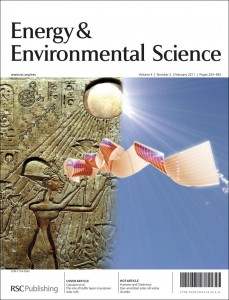 We would like to share with you some great new theoretical and computational research published in Energy & Environmental Science. From communications of the highest novelty to reviews from experts in their field, you can read these important articles today.
We would like to share with you some great new theoretical and computational research published in Energy & Environmental Science. From communications of the highest novelty to reviews from experts in their field, you can read these important articles today.
With an Impact Factor of 9.49 and ranked #1 in its field, Energy & Environmental Science is the ideal place to publish your research. We invite you to submit your best theoretical and computational research to Energy & Environmental Science.
Read this high-impact theoretical and computational research:
Prediction of solid oxide fuel cell cathode activity with first-principles descriptors
Yueh-Lin Lee, Jesper Kleis, Jan Rossmeisl, Yang Shao-Horn and Dane Morgan
DOI: 10.1039/C1EE02032C
Theoretical studies of dye-sensitised solar cells: from electronic structure to elementary processes
Natalia Martsinovich and Alessandro Troisi
DOI: 10.1039/C1EE01906F
Proton-coupled electron transfer: classification scheme and guide to theoretical methods
Sharon Hammes-Schiffer
DOI: 10.1039/C2EE03361E
Quantum-mechanics-based design principles for solid oxide fuel cell cathode materials
Michele Pavone, Andrew M. Ritzmann and Emily A. Carter
DOI: 10.1039/C1EE02377B
Accelerated computational discovery of high-performance materials for organic photovoltaics by means of cheminformatics
Roberto Olivares-Amaya, Carlos Amador-Bedolla, Johannes Hachmann, Sule Atahan-Evrenk, Roel S. Sánchez-Carrera, Leslie Vogt and Alán Aspuru-Guzik
DOI: 10.1039/C1EE02056K
A perspective on the modeling of biomass processing
Na Guo, Stavros Caratzoulas, Douglas J. Doren, Stanley I. Sandler and Dionisios G. Vlachos
DOI: 10.1039/C2EE02663E
How copper catalyzes the electroreduction of carbon dioxide into hydrocarbon fuels
Andrew A. Peterson, Frank Abild-Pedersen, Felix Studt, Jan Rossmeisl and Jens K. Nørskov
DOI: 10.1039/C0EE00071J
The predicted crystal structure of Li4C6O6, an organic cathode material for Li-ion batteries, from first-principles multi-level computational methods
Dong-Hwa Seo, Hyungjun Kim, Haegyeom Kim, William A. Goddard and Kisuk Kang
DOI: 10.1039/C1EE02410H
Multiscale simulation and modelling of adsorptive processes for energy gas storage and carbon dioxide capture in porous coordination frameworks
Zhonghua Xiang, Dapeng Cao, Jianhui Lan, Wenchuan Wang and Darren P. Broom
DOI: 10.1039/C0EE00049C
Modeling and simulation of nuclear fuel materials
Ram Devanathan, Laurent Van Brutzel, Alain Chartier, Christine Guéneau, Ann E. Mattsson, Veena Tikare, Timothy Bartel, Theodore Besmann, Marius Stan and Paul Van Uffelen
DOI: 10.1039/C0EE00028K
Oxygen diffusion in solid oxide fuel cell cathode and electrolyte materials: mechanistic insights from atomistic simulations
Alexander Chroneos, Bilge Yildiz, Albert Tarancón, David Parfitt and John A. Kilner
DOI: 10.1039/C0EE00717J
First-principles modelling of complex perovskite (Ba1-xSrx)(Co1-yFey)O3-δ for solid oxide fuel cell and gas separation membrane applications
Yuri A. Mastrikov, Maija M. Kuklja, Eugene A. Kotomin and Joachim Maier
DOI: 10.1039/C0EE00096E
Prospects of on-chip fuel cell performance: improvement based on numerical simulation
Satoshi Tominaka, Sousuke Ohta, Tetsuya Osaka and Richard Alkire
DOI: 10.1039/C0EE00179A
Computational screening of perovskite metal oxides for optimal solar light capture
Ivano E. Castelli, Thomas Olsen, Soumendu Datta, David D. Landis, Søren Dahl, Kristian S. Thygesen and Karsten W. Jacobsen
DOI: 10.1039/C1EE02717D
Multiscale molecular simulations of the nanoscale morphologies of P3HT:PCBM blends for bulk heterojunction organic photovoltaic cells
Cheng-Kuang Lee, Chun-Wei Pao and Chih-Wei Chu
DOI: 10.1039/C1EE01508G











